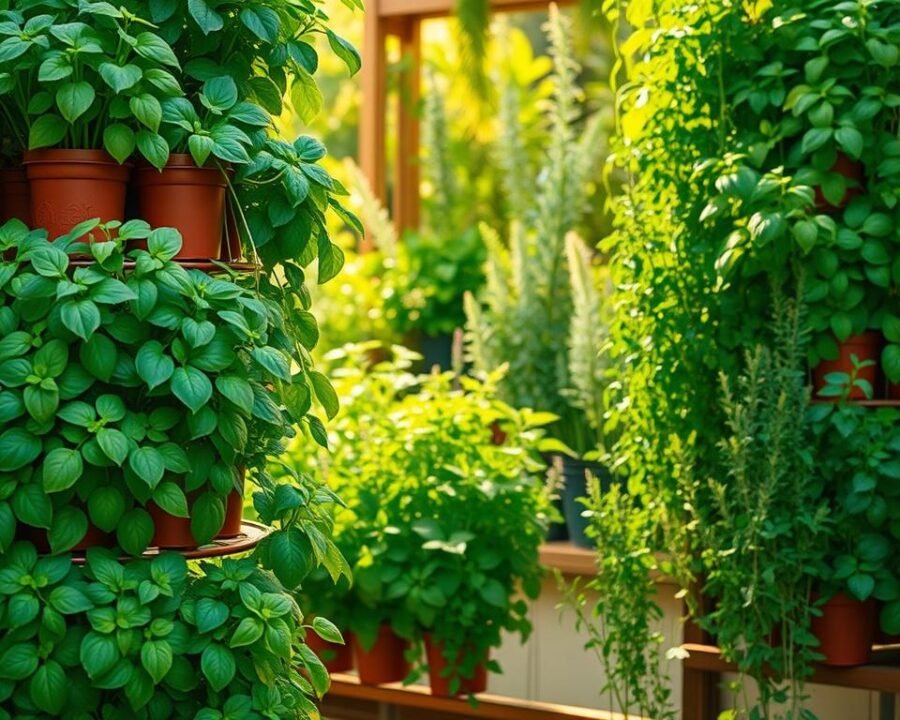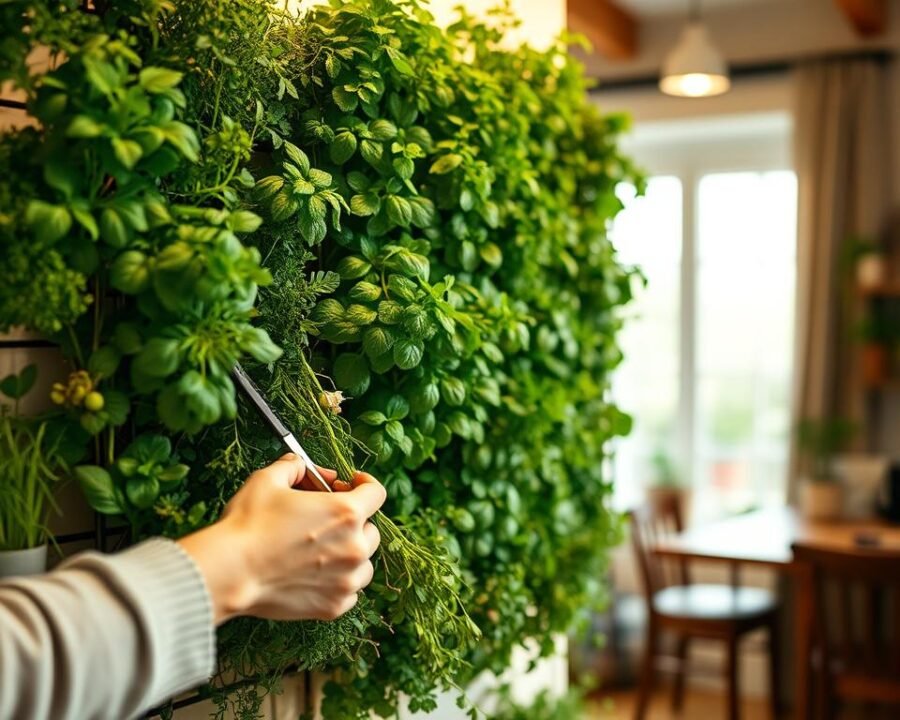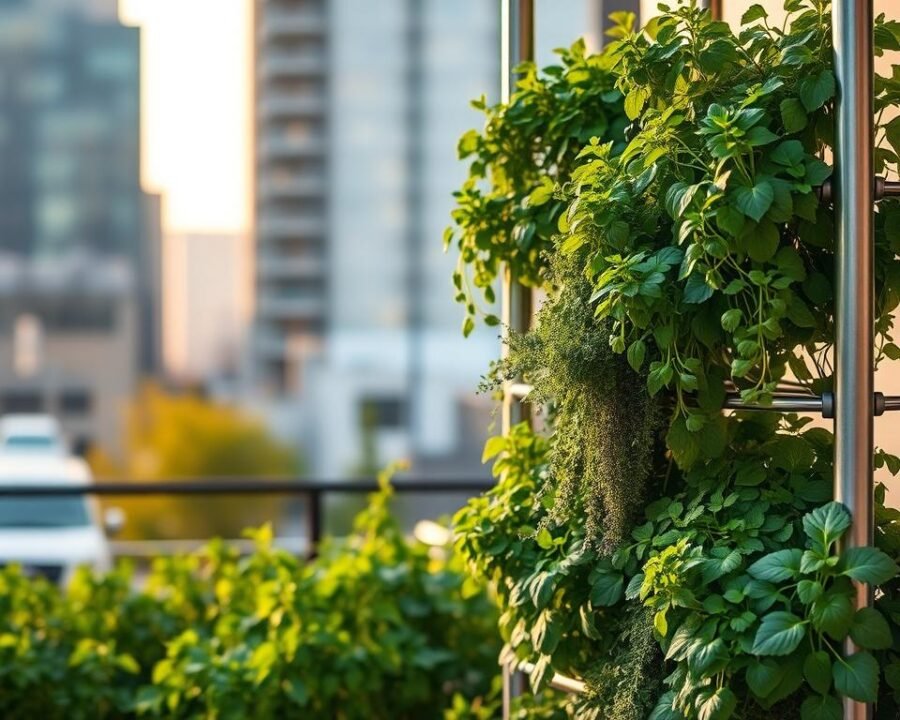Fresh herbs elevate every meal, but store-bought bundles often wilt before we use them. What if we could snip fragrant basil or mint right from our kitchen? Compact setups make it possible, even in small apartments.
Urban living doesn’t mean sacrificing homegrown flavors. Patios, balconies, or sunny windowsills work perfectly. Low-maintenance options like chives thrive with minimal care, offering endless harvests.
Systems like the GreenStalk Vertical Planter hold up to 30 plants, turning tight spaces into lush greenery. Imagine stepping outside for rosemary instead of paying $4 per sprig. The joy—and savings—add up quickly.
Key Takeaways
- Ideal for patios, balconies, or kitchens with limited space.
- Herbs like basil and mint grow easily in compact containers.
- Vertical designs maximize planting capacity without clutter.
- Fresh cuts reduce grocery costs and waste.
- Beginner-friendly with minimal upkeep required.
Why a Vertical Herb Garden Is Perfect for Your Home
City dwellers often struggle to find room for greenery, but vertical setups solve this elegantly. These systems turn unused walls or railings into thriving plant displays. Even a sunny windowsill becomes a mini farm.
Maximizing Small Spaces
Compact designs like the GreenStalk Vertical Planter stack herbs in tiers. Rosemary, thyme, and mint adapt well to these containers. No yard? Balconies or patios work perfectly.
Key advantages:
- Wall-mounted planters free up floor space.
- Tiered systems organize herbs neatly—no tangled roots.
- Rail hooks let renters avoid permanent changes.
Easy Access and Maintenance
Traditional gardens require bending and weeding. Vertical setups simplify care:
- Prune at eye level—no back strain.
- Pest-resistant herbs like lavender protect neighboring plants.
- Self-watering containers reduce daily chores.
“Vertical gardens cut harvest time in half—just snip what you need.”
Portable options suit renters. Move planters to chase sunlight or avoid harsh weather. Fresh flavors grow effortlessly, even in tight spaces.
Benefits of Growing Your Own Vertical Herb Garden
Nothing beats the vibrant taste of freshly picked herbs right from your living space. These compact setups deliver more than convenience—they’re a gateway to richer flavors, savings, and a greener lifestyle.
Fresh Herbs at Your Fingertips
Store-bought basil pales in comparison to homegrown leaves. The difference? Oils in freshly snipped herbs like oregano or thyme are more potent, elevating dishes like caprese salad or roasted veggies. *Lack of transport time means peak flavor* lands directly on your plate.
Studies show homegrown greens, like lettuce, pack more vitamins. With a vertical setup, you’re not just growing food—you’re cultivating nutrition.
Cost-Effective and Sustainable
Save hundreds yearly: A $2 basil plant yields 10+ bunches versus $3–$5 per supermarket purchase. Multiply that across mint, parsley, and rosemary—your wallet thanks you.
Eco perks shine too:
- No plastic clamshells or wasted sprigs.
- Reduced “food miles” lower carbon footprints.
- Lavender doubles as a pollinator magnet, boosting local ecosystems.
Enhancing Your Home’s Aesthetics
Purple basil and flowering lavender add pops of color to walls or railings. Pair them with edible blooms like nasturtiums for a living artwork.
“A vertical garden isn’t just functional—it’s a conversation starter.”
Healthy soil and smart placement turn utilitarian setups into eye-catching features. Even a tiny balcony feels lush with cascading greenery.
Best Vertical Herb Garden You Need to Try: Top Picks
Certain herbs shine brighter than others in compact setups. Whether you crave bold flavors or calming scents, these selections thrive in limited spaces.

Basil: A Must-Have for Every Garden
Starter plants speed up growth, letting you harvest sooner. Basil craves full sun—place it where light pours in for 6+ hours daily. Pair it with tomatoes in recipes or planters for a classic duo.
Rosemary: Hardy and Fragrant
This perennial thrives year-round, even in cooler climates. Its woody stems suit tiered setups, staying tidy. Pro tip: Snip sprigs for roasted meats or infused oils.
Mint: Fast-Growing but Contained
Plant mint in bottom-tier planters to curb its spread. Varieties like peppermint add zest to teas and salads. Keep soil moist but not soggy.
Thyme: Versatile and Low-Maintenance
Lemon thyme’s citrusy punch elevates seafood and soups. It tolerates dry spells, making it ideal for forgetful waterers. GreenStalk systems showcase its trailing beauty.
Lavender: Beautiful and Functional
Use blooms in desserts or as natural decor. Growing from seed? Opt for starter plants—they’re less finicky. Place near seating areas to enjoy its soothing aroma.
| Herb | Light Needs | Water | Best Tier |
|---|---|---|---|
| Basil | Full sun | Moderate | Top/middle |
| Rosemary | Full sun | Low | Any |
| Mint | Partial shade | High | Bottom |
| Thyme | Full sun | Low | Middle |
| Lavender | Full sun | Low | Top |
Mix and match these herbs for a vibrant, fragrant display. Their adaptability makes them stars in any small-space garden.
How to Set Up Your Vertical Herb Garden
Transforming a bare wall into a lush, edible display starts with smart setup choices. Whether you’re working with a balcony rail or a sunny kitchen corner, the right materials and methods ensure success.

Choosing the Right Planter or Structure
Planters come in many styles, each suited to different spaces. Lightweight plastic tiers, like the GreenStalk 5-tier design, hold up to 30 plants without crowding. Ceramic options add aesthetic appeal but need sturdy support.
For renters, wall pockets or rail hooks avoid permanent changes. Pro tip: Line wooden structures with weed barrier cloth to prevent rot.
Selecting the Best Soil and Containers
Healthy roots need quality soil. Mix organic potting soil with perlite for drainage—soggy roots spell disaster. Self-watering containers reduce maintenance, while terra cotta pots breathe better.
- Plastic: Lightweight, affordable, retains moisture.
- Ceramic: Stylish but heavier; ideal for stable surfaces.
- Fabric: Promotes air pruning; folds for storage.
Planting Your Herbs: Step-by-Step
- Prep containers: Add gravel for drainage, then soil mix.
- Divide starters: Gently separate store-bought basil roots to spread growth.
- Plant companions: Pair basil with tomatoes—they deter pests mutually.
- Mulch: A thin layer locks in moisture and wards off weeds.
This project rewards patience. Within weeks, your vertical garden will yield fresh flavors, turning any fence or railing into a functional masterpiece.
Caring for Your Vertical Herb Garden
Keeping plants thriving in compact setups requires simple but crucial care steps. With the right balance of water, light, and timely trimming, your greens will flourish. Here’s how to nurture them for endless harvests.

Watering and Sunlight Needs
Leafy herbs like spinach crave frequent water, but rosemary prefers drier soil. Drip irrigation systems deliver consistent moisture without overdoing it. Check container drainage holes weekly—soggy roots invite rot.
Place thirstier mint in partial shade, while basil soaks up 6+ hours of direct sunlight. Rotate planters monthly for even growth.
Pruning and Harvesting Tips
Use the “cut-and-come-again” method: snip only one-third of basil or parsley stems. This encourages bushier regrowth. Always trim yellowing leaves to redirect energy.
“Regular pruning doubles harvests—think of it as a haircut for healthier growth.”
Dealing with Common Pests
Aphids hate neem oil—mix 1 tsp with water and spray leaves weekly. Companion planting marigolds deters beetles naturally. For overgrown rosemary, transplant it to larger containers or in-ground beds.
Healthy soil and air circulation prevent most pests. Spot mold? Reduce watering and improve airflow.
Conclusion
Growing fresh flavors at home is simpler than many think. With compact setups, anyone can get started, regardless of space or experience. Basil, mint, and rosemary thrive with basic care, rewarding you with vibrant tastes.
Join a community of urban growers to share tips and triumphs. Online forums buzz with creative solutions for small spaces. Your first harvest—whether pesto or mint tea—is just weeks away!
We’re grateful you’re embracing sustainable living. Every snipped sprig reduces waste and connects you to your meals. Thanks for letting us guide your green journey.
Get started today—drop a comment below with your favorite herbs or questions!
